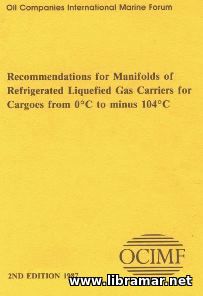 This is another guidebook issued by the OCIMF and providing valuable industry recommendations to anyone involved in the marine transportation of the LNG cargoes and their handling. The arrangement of the material in this publication is similar to the one in the general OCIMF Recommendations for Manifolds of Refrigerated LNG Carriers. There are twelve chapters in this compact yet quite comprehensive volume.
The book opens with some introductory information and list of definitions provided with explanations, followed by the chapters on ship size categories and cargo manifold position. The other chapters are covering the specifications and spillage requirements, service lines and bunker connections, lighting of the manifold area and support of the cargo hose at the vessel's side.
There are several tables and figures supplementing the main text of the document and providing some additional information, such as the size of flanges and their spacing, forces acting on the flanges, cargo and bunker reducers and presentation flanges, SWL of the lifting equipment etc. this document will be of practical use to those willing to perform their day to day activities in correct, safe and efficient manner.
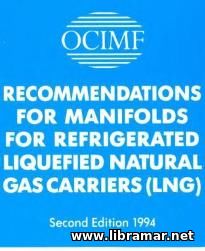 This is the second edition of the very practically useful publication released by the recognized and authoritative OCIMF organization. The recommendations contained in the present volume were developed with the intention to promote conformity in the manifold arrangements on board LNG carriers and contribute to the operational efficiency. It will also help to better plan the loading and discharge positions on the newly introduced jetties.
The specification contained herein was prepared on the basis of the practical experience of the many operators and berth specialists, shipbuilders and naval architects, manufacturers of the equipment and other people engaged in the handling and transportation of the liquid natural gas. The content of the guidebook has already been very well met by the owners of the LNG vessels as well as the builders and they do not imply the alteration of any existing carrier.
In fact, these recommendations should be considered applicable to some of the LNG transporting vessels featuring the midship arrangement of the manifold. Eight chapters of the document cover the ship volume categories, cargo manifold position and specifications, bunker fuel connections and other important areas.
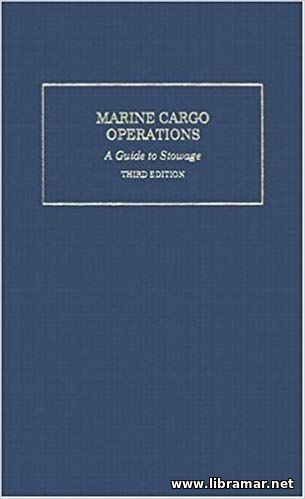 The safe and cost-effective transportation of cargoes is an ongoing mission. The present edition of the title was released to help the people involved in the shipping industry by giving them in a single volume all major techniques and principles of cargo operations duly explained. The publication is also intended to acquaint the marine officers with the fundamental principles of cargo stowage.
The content of the volume bases on the huge practical experience of the author who has provided a detailed descriptions of the most practical and effective procedures and methods. The containerization has been paid particular attention in the pages of this edition together with the responsibilities normally assigned to the merchant ship officers for the transportation.
The author has made a good attempt to discuss all important tasks, facts and concepts that affect marine cargo transportation operations as he could encompass within a single book. Eight chapters of the book provide valuable information about the innovations in the field of maritime transportation, cargo responsibility matters, handling and stowage of materials, general and hazardous cargoes, planning, preparation of the cargo spaces, and other important aspects, making this book a must-have one for all people involved in subject operations.
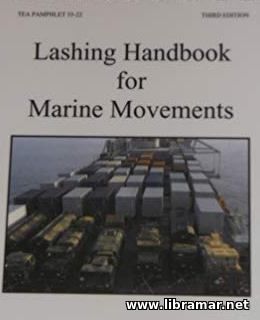 The official document released by the Transportation Engineering Agency. The intention of the authors of the present publication was to provide industry with the correct lashing and lifting techniques and methods to be used for loading both general and military cargoes and securing them on board seagoing ships. The content of the volume includes important equipment characteristics.
The main body of the document is arranged in seven chapters with the first one being introductory. The other sections provide necessary tips and explain the commonly made mistakes, and give all required instructions on lashing hardware and wheeled vehicles, trailers and tracked vehicles, and containers. Note that the general technical guidance provided in the second half of the book have some limitations but are still applicable.
The main portion of the book is dealing with the lifting of the cargoes in the course of the port operations. There are also three appendices providing information about the development and implementation of the cargo restraint criteria applicable to the marine transport, explain the deck strength calculations, and address the procedures for the blocking and bracing considered effective and recommended.
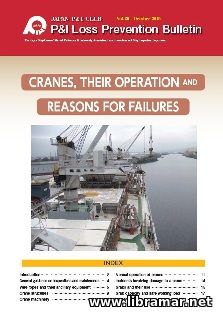 This publication was prepared and released by the Japan P&I Club. The intention of the authors was to give some brief introduction to the shipboard cranes and their operation, with due attention paid to the most common reasons for their failures. This compact title provides general guidelines on the routine maintenance and inspections of the cranes. The structure and machinery of the cranes have been discussed together with the wire ropes.
Then the content proceeds to the crane operation and the incidents that involve crane damage. The grabs have been discussed separately together with their capacity, SWL and use. And of course, the authors concentrated on safety matters as well. The cargo handling cranes are installed on most of the vessels, especially general cargo ships and bulk carriers.
They are normally quite robust units continuing to work with nearly minimum maintenance; however, they are complex machinery units incorporating many components that are manufactured to the fine tolerance values. All of the components shall function correctly through the entire lifetime of the crane. The cranes shall be duly maintained and checked at a specified time intervals to make sure they are operated safely and correctly.
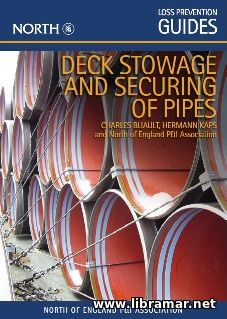 The publication was released by North of England P&I Association in order to provide guidance to the stowage and securing of the pipes carried on board ships. It starts with some general technical information about handling pipes and applicable regulatory framework.
The second chapter will give valuable guidelines covering the characteristics of pipes, it will tell you what steps shall be taken prior to the loading, how to stow and secure pipes - and theoretical information will be supplemented with the worked examples.
The next chapter of the booklet is covering the protection of the pipes, construction of the stanchions, securing arrangements etc. There are two appendices to the main part of the publication, describing the advanced calculation method and providing necessary information and examples of verification of the securing alternatives for the pipes stowed on deck.
Needless to say that this compact yet very informative volume will be of great practical use for all parties involved in marine transportation of pipes and is therefore highly recommended to the crew members of the vessels transporting pipes as well as to any other person dealing with arrangement of their transportation.
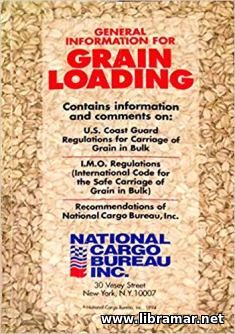 The content of the present booklet on proper loading of grain intended for marine transportation was prepared by the specialists of the National Cargo Bureau with the aim of facilitating the grain loading in bulk in American ports by providing all required information on the relevant regulatory framework; it also gives some general technical information, such as the grain data and associated stability calculation together with the stowage arrangements etc.
The original edition published back in 1994 has been thoroughly revised and updated in 2013. The volume opens with the brief information about IMO and principle and limitations outlined in the Grain Rules. The next chapter of the book is dealing with the requirements covering the heeling moments and stowage factor, trimming and leveling, document of authorization, angle of flooding, lashing and strapping, and many other factors.
The chapter addressing the grain loading covers preparation of the vessel for grain loading, trim and stability problems, different methods of securing, necessary precautions to be taken, allowance tables, standard bushel weights etc. In short, the publication is very practical and shall be possessed on board vessels engaged in transportation of the grain, especially to and from U.S. ports.
 The present manual written by two prominent industry experts is intended for all people engaged in the process of sampling an subsequent analysis of the crude oil after their production and stabilization. The content of the publication will be particularly useful to the operators of the tankers carrying crude oil and to the workers of the terminals storing oil. It will also present practical interest to the lab personnel assigned responsibility for the characterization of the crude oil and to the refiners processing the oil.
And, of course, the traders dealing with sale or acquisition of the crude oil will also appreciate the book. The volume opens with the compact but comprehensive glossary of terms used in the industry when dealing with crude oil. The first section is devoted to the oil sampling including manual sampling and sample transfers, mixing systems and storage of samples, auto-sampling and mixing methods etc.
The second section is the inspection assays - here the readers will find information about the API gravity and density, water and sediment, salt content and fluidity, carbon residue, total acid number, characterization factor, microwave digestion, trace elements, nitrogen content etc. The other sections of the volume deal with the quality assurance, compatibility and stability of crude oil, using oil and fuel and other important topics. Three appendixes will give you some additional information.
|







